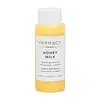What's inside
What's inside
 Key Ingredients
Key Ingredients

 Benefits
Benefits

 Concerns
Concerns

No concerns
 Ingredients Side-by-side
Ingredients Side-by-side

Water
Skin ConditioningAlcohol Denat.
AntimicrobialGlycerin
HumectantTriethylhexanoin
MaskingCaprylic/Capric Triglyceride
MaskingDipropylene Glycol
Humectant1,2-Hexanediol
Skin ConditioningHydrogenated Lecithin
EmulsifyingPanthenol
Skin ConditioningCarbomer
Emulsion StabilisingTromethamine
BufferingC14-22 Alcohols
Emulsion StabilisingSqualane
EmollientButylene Glycol
HumectantPolysorbate 60
EmulsifyingMacadamia Ternifolia Seed Oil
EmollientArachidyl Glucoside
EmulsifyingButyrospermum Parkii Butter
Skin ConditioningGlyceryl Stearate
EmollientStearic Acid
CleansingCeramide NP
Skin ConditioningCholesterol
EmollientDimethicone
EmollientPEG-100 Stearate
Alchemilla Vulgaris Leaf Extract
AntioxidantAlthaea Officinalis Root Extract
Skin ConditioningRosa Damascena Flower Extract
MaskingSpiraea Ulmaria Flower Extract
Skin ConditioningViola Tricolor Extract
EmollientCalendula Officinalis Flower Extract
MaskingAvena Sativa Kernel Extract
AbrasiveNepeta Cataria Extract
TonicRubus Idaeus Leaf Extract
Skin ConditioningStellaria Media Extract
Skin ConditioningBaptisia Tinctoria Root Extract
Skin ConditioningEuphrasia Officinalis Extract
AntimicrobialThuja Occidentalis Leaf Extract
AntioxidantSymphytum Officinale Leaf Extract
Skin ConditioningAchillea Millefolium Flower Extract
AntioxidantTrifolium Pratense Flower Extract
AstringentMenyanthes Trifoliata Leaf Extract
Skin ConditioningSalix Alba Bark Extract
AstringentCitrus Aurantium Dulcis Peel Oil
MaskingCitrus Aurantifolia Oil
CleansingPelargonium Graveolens Flower Oil
MaskingRosmarinus Officinalis Leaf Oil
MaskingLimonene
PerfumingCitronellol
PerfumingGeraniol
PerfumingCitral
PerfumingLinalool
PerfumingWater, Alcohol Denat., Glycerin, Triethylhexanoin, Caprylic/Capric Triglyceride, Dipropylene Glycol, 1,2-Hexanediol, Hydrogenated Lecithin, Panthenol, Carbomer, Tromethamine, C14-22 Alcohols, Squalane, Butylene Glycol, Polysorbate 60, Macadamia Ternifolia Seed Oil, Arachidyl Glucoside, Butyrospermum Parkii Butter, Glyceryl Stearate, Stearic Acid, Ceramide NP, Cholesterol, Dimethicone, PEG-100 Stearate, Alchemilla Vulgaris Leaf Extract, Althaea Officinalis Root Extract, Rosa Damascena Flower Extract, Spiraea Ulmaria Flower Extract, Viola Tricolor Extract, Calendula Officinalis Flower Extract, Avena Sativa Kernel Extract, Nepeta Cataria Extract, Rubus Idaeus Leaf Extract, Stellaria Media Extract, Baptisia Tinctoria Root Extract, Euphrasia Officinalis Extract, Thuja Occidentalis Leaf Extract, Symphytum Officinale Leaf Extract, Achillea Millefolium Flower Extract, Trifolium Pratense Flower Extract, Menyanthes Trifoliata Leaf Extract, Salix Alba Bark Extract, Citrus Aurantium Dulcis Peel Oil, Citrus Aurantifolia Oil, Pelargonium Graveolens Flower Oil, Rosmarinus Officinalis Leaf Oil, Limonene, Citronellol, Geraniol, Citral, Linalool
Aloe Barbadensis Leaf Juice
Skin ConditioningSaccharomyces Ferment Filtrate
HumectantPropanediol
SolventBetaine
HumectantIsopentyldiol
HumectantWater
Skin ConditioningGlycerin
Humectant1,2-Hexanediol
Skin ConditioningHoney Extract
HumectantCeramide NP
Skin ConditioningAnthemis Nobilis Flower Extract
MaskingPanthenol
Skin ConditioningSqualane
EmollientOpuntia Ficus-Indica Stem Extract
Skin ConditioningArginine
MaskingPolyacrylate Crosspolymer-6
Emulsion StabilisingPolyglyceryl-10 Stearate
Skin ConditioningGlucomannan
Skin ConditioningSodium Benzoate
MaskingPotassium Sorbate
PreservativeCitric Acid
BufferingSodium Phytate
Hydroxyacetophenone
AntioxidantHydrogenated Lecithin
EmulsifyingSucrose Stearate
EmollientCaprylyl Glycol
EmollientMaltodextrin
AbsorbentAloe Barbadensis Leaf Juice, Saccharomyces Ferment Filtrate, Propanediol, Betaine, Isopentyldiol, Water, Glycerin, 1,2-Hexanediol, Honey Extract, Ceramide NP, Anthemis Nobilis Flower Extract, Panthenol, Squalane, Opuntia Ficus-Indica Stem Extract, Arginine, Polyacrylate Crosspolymer-6, Polyglyceryl-10 Stearate, Glucomannan, Sodium Benzoate, Potassium Sorbate, Citric Acid, Sodium Phytate, Hydroxyacetophenone, Hydrogenated Lecithin, Sucrose Stearate, Caprylyl Glycol, Maltodextrin
 Reviews
Reviews

Ingredients Explained
These ingredients are found in both products.
Ingredients higher up in an ingredient list are typically present in a larger amount.
1,2-Hexanediol is a synthetic liquid and another multi-functional powerhouse.
It is a:
- Humectant, drawing moisture into the skin
- Emollient, helping to soften skin
- Solvent, dispersing and stabilizing formulas
- Preservative booster, enhancing the antimicrobial activity of other preservatives
Ceramide NP is a type of ceramide.
Ceramides are intercellular lipids naturally found in our skin that bonds dead skin cells together to create a barrier. They are known for their ability to hold water and thus are a great ingredient for dry skin.
Ceramides are an important building block for our skin barrier. A stronger barrier helps the skin look more firm and hydrated. By bolstering the skin ceramides act as a barrier against irritating ingredients. This can help with inflammation as well.
If you would like to eat ceramides, sweet potatoes contain a small amount.
Read more about other common types of ceramides here:
Ceramide AP
Ceramide EOP
Glycerin is already naturally found in your skin. It helps moisturize and protect your skin.
A study from 2016 found glycerin to be more effective as a humectant than AHAs and hyaluronic acid.
As a humectant, it helps the skin stay hydrated by pulling moisture to your skin. The low molecular weight of glycerin allows it to pull moisture into the deeper layers of your skin.
Hydrated skin improves your skin barrier; Your skin barrier helps protect against irritants and bacteria.
Glycerin has also been found to have antimicrobial and antiviral properties. Due to these properties, glycerin is often used in wound and burn treatments.
In cosmetics, glycerin is usually derived from plants such as soybean or palm. However, it can also be sourced from animals, such as tallow or animal fat.
This ingredient is organic, colorless, odorless, and non-toxic.
Glycerin is the name for this ingredient in American English. British English uses Glycerol/Glycerine.
Learn more about GlycerinHydrogenated Lecithin is created from the hydrogenation of lecithin (a group of phospholipids). Hydrogenation is a chemical reaction between hydrogen and another element.
This ingredient is an emollient and emulsifier. As an emollient, it helps soften skin by trapping moisture within. As an emulsifier, it prevents oil and water ingredients from separating.
Panthenol is a common ingredient that helps hydrate and soothe the skin. It is found naturally in our skin and hair.
There are two forms of panthenol: D and L.
D-panthenol is also known as dexpanthenol. Most cosmetics use dexpanthenol or a mixture of D and L-panthenol.
Panthenol is famous due to its ability to go deeper into the skin's layers. Using this ingredient has numerous pros (and no cons):
Like hyaluronic acid, panthenol is a humectant. Humectants are able to bind and hold large amounts of water to keep skin hydrated.
This ingredient works well for wound healing. It works by increasing tissue in the wound and helps close open wounds.
Once oxidized, panthenol converts to pantothenic acid. Panthothenic acid is found in all living cells.
This ingredient is also referred to as pro-vitamin B5.
Learn more about PanthenolSqualane is an emollient that helps the skin hold onto moisture. It's an oily liquid that occurs naturally in certain types of fish and plant oils.
Because squalane boosts hydration in the skin, it also comes with plenty of benefits: it is an antioxidant and can help fight free radicals and skin damage. Squalane is also found to have a detoxifying effect when applied.
Squalane comes from squalene, which occurs naturally within the sebum of our skin. It is one of the oils our skin produces to keep itself hydrated. Squalane is the hydrogenated version of squalene and has a longer shelf life.
Research shows that squalane is non-irritating (even at 100% concentration).
In general, it's a fantastic ingredient. It does a great job at hydrating the skin, and it's suitable for those with sensitive skin.
The source of squalane may impact malassezia / fungal acne. This is because olive oil derived squalane can contain impurities such as fatty acids and plant waxes. Sugarcane derived squalane is recommended for anyone with malassezia concerns.
Is squalane vegan?
This depends on the source. Squalane can be derived from both plants and animals. Most squalane used in skincare comes from plants.
Please note: the source of squalane is only known if disclosed by the brand. We recommend reaching out to the brand if you have any questions about their squalane.
Read more about squalene with an "e".
Is squalane an oil?
Squalane is often called an oil, but it’s technically not; it’s a hydrocarbon, meaning it’s only made of carbon and hydrogen, unlike true oils which are triglycerides made of fatty acids and glycerol.
The term “oil-free” isn’t regulated, so companies can define it however they want. Some exclude all oils, while others just avoid mineral oil or comedogenic oils.
While some people avoid oils thinking they cause breakouts, the right kind of oil (or oil-like ingredient like squalane) can actually help balance and hydrate your skin. It’s worth testing out simple oils or squalane to see what works best for your skin.
Learn more about SqualaneWater. It's the most common cosmetic ingredient of all. You'll usually see it at the top of ingredient lists, meaning that it makes up the largest part of the product.
So why is it so popular? Water most often acts as a solvent - this means that it helps dissolve other ingredients into the formulation.
You'll also recognize water as that liquid we all need to stay alive. If you see this, drink a glass of water. Stay hydrated!
Learn more about Water